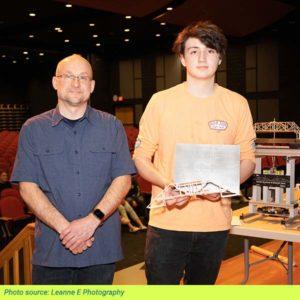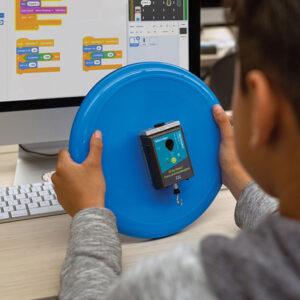
Sharing ideas and inspiration for engagement, inclusion, and excellence in STEM
Renewable Energy Investigations: Exploring the Energy Production Impact in Your Community
As the clean energy industry—especially wind power—grows rapidly, engineering, environmental science, and CTE classrooms have an exciting opportunity to explore real-world science concepts that impact both our environment and society. Teaching the science behind renewable energy isn’t only about preparing students for future careers; it’s also a pathway to understanding environmental equity and how energy infrastructure affects communities differently.
Three Light and Wave Physics Investigations with the Go Direct Light and Color Sensor
Ever wonder why car headlights look dim from a distance but shine bright up close? Or how your sunglasses can block out glaring light? These are just a few of the real-world phenomena your students can explore with the Go Direct® Light and Color Sensor. Combining multiple sensors to measure light intensity across the visible and ultraviolet parts of the electromagnetic spectrum, this versatile tool can be used in a wide range of science applications. We’re highlighting three hands-on experiments that invite students to investigate real-world phenomena and explore the physics behind light and waves.
Where Math Meets Science: Connecting Vernier Go Direct Sensors and TI-Nspire Technology
Looking for ways to make math more accessible to your students? Help them build confidence in math and science concepts by using real-time data collection! When students are tasked with exploring real-world phenomena, math transforms from an abstract, intimidating concept into a practical tool that students can use to develop and articulate answers to questions like, “Why are headlights on a car dimmer at a distance?” or “Why do I feel warmer wearing a black shirt on a sunny day?”
With enhanced compatibility between Vernier and Texas Instruments, students can now explore math in tangible, real-world scenarios by wirelessly capturing and analyzing real-time data on their TI-Nspire™ CX II graphing calculators. By integrating math and science, educators can enrich student comprehension, deepen their understanding of the natural world, and prepare students for careers in STEM.Ready, Set, Science! Get Your Science Game On with These Four Sports‑Themed Experiments
We had such a blast at NSTA Denver 2024 last week! One of our big highlights this year was getting to mix science and sports with fun, athletics-inspired activities. Below we’re sharing four of our favorite sports-themed experiments you can try out to elevate your classroom game!
KidWind Challenges: Engaging Students in Real-World Applications of Renewable Wind Energy
In an era where renewable energy plays a major role in a sustainable future, educational initiatives like KidWind Challenges are increasingly relevant. These practical design challenges get students involved in meaningful conversations about renewable energy through the exploration of wind and solar power. In teams, middle and high school students globally engage in designing, building, and testing small-scale wind turbines and solar structures, deepening their understanding and investment in renewable energy.
Empowering Students through Career-Based Learning and STEM Representation in Physics and Engineering Classrooms
Anticipating a projected 10.8% growth in STEM occupations over the next decade, the STEM Academy of Hollywood, a pilot high school in Hollywood, California, emphasizes career-focused education. The school centers on two career pathways: Engineering and Biomedical Science, utilizing curriculum from Project Lead the Way. Regine Rosas, who comes from a biomedical engineering background, teaches physics and electives in the engineering pathway to help students prepare for the evolving STEM landscape.
TI Graphing Calculators + Vernier Go Direct® Sensors = A Match Made in STEM!
What do science students get when teachers connect Vernier Go Direct® sensors with TI’s Python-capable graphing calculators? An easy-to-use, portable and wireless data collection system that gets them more engaged in their learning!
Harnessing the Power of Solar Energy Exploration with KidWind
Looking for a way to explore solar energy in your class—and promote hands-on science learning at the same time? KidWind, our line of renewable energy products, includes solar panels appropriate for teaching students from K–12 to college.
Hands-On Physics Learning with Water Rockets, Mousetrap Race Cars, Bridges, and Wind Turbines
All students benefit when they can apply physics principles and concepts by building something. Having that real-world connection can help make physics easier to understand. As an added bonus, it can also increase student engagement.
Latino STEM Alliance: Sparking Interest in Science Exploration for Underserved Youth with Robotics and Project-Based Learning
Hispanic workers represent just 8 percent of the STEM workforce, according to the Pew Research Center. The Latino STEM Alliance (LSA) seeks to increase that number.
Sustainability-Focused Projects Provide Engineering and Manufacturing Students with Skills for Postsecondary Success
Roosevelt Community Education Center, an alternative high school in Rockford, Illinois, provides a nontraditional learning environment with unique educational opportunities for students at the secondary level, as well as students 21 and older who are enrolled in the adult education program.
Using KidWind to Teach First-Year College Students How to Think Like an Engineer
At the University at Buffalo, the introductory first-year engineering course consists of about 600 students—and the amount of academic preparation and experience, as well as the specific engineering degree program each student wants to pursue (e.g., civil, electrical, mechanical), can vary widely. To create a single project that worked for each student, William Wild, director of the engineering first-year experience, and his colleagues found the perfect solution with KidWind.
Five Research-Based Best Practices for STEM Education
The quest for high-quality STEM education starts with having a solid foundation grounded in research. But what exactly does the research say about high-quality STEM education?
Using Stirling Engines and Vernier Technology for Hands-On Physics Investigations
Note: A version of this story was originally posted on the Vernier website in August 2021.
Versatile Go Direct® Light and Color Sensor Helps Illuminate Concepts Across the Science Curriculum
Good things come in small packages—including the Go Direct Light and Color Sensor.
Getting Students Involved and Invested in Their Own Learning with User-Friendly Vernier Technology: A Q&A with Alexandra Boyd
Alexandra Boyd teaches AP Physics at Apex Friendship High School in Apex, North Carolina. Last year, she won a 40th anniversary educator grant from Vernier, which included $1,000 in Vernier technology. We sat down with Boyd to discuss the impact of the grant on her and her students. The interview has been edited for length and clarity.
Python® and LabQuest®: Opening Up Opportunities for STEM Educators and Students
When you think about ways to teach science, coding might not be the first thing that comes to mind.
Giving Students Hands-On Experience with the Engineering Design Process
What do you get when you take 40 to 60 high school students from across the northeast corner of the Keystone State, add a bunch of basswood, and throw in physics and engineering concepts?
KidWind: Renewable Energy Meets Hands-On Science Learning for Students of All Ages
Whether you are a K–12 or college educator, KidWind offers a versatile, affordable way to teach the science of renewable energy—and that’s just the start.
Interning During a Global Pandemic
For the past 30 years, Vernier Software & Technology participates in the Apprenticeships in Science & Engineering (ASE) program to give students the opportunity to see what it’s like to work at a STEM company. This internship normally takes place in person, but 2020 was not a routine year. This is the story of our resilient intern, the great support she received from her team, and the important work she was able to do from home.
Vernier and SAM Labs Help Educators Prepare Students for the Future
The deeper we dive into this technology-driven century, the more important it is for students to gain the skills needed for the future. Coding helps young learners build valuable experience using the 4Cs of 21st century skills: critical thinking, collaboration, creativity, and communication.
Engineering Outreach with Vernier Technology
Maija Benitz, Assistant Professor of Engineering at Roger Williams University (RWU), has just deployed 29 upper-level engineering students, along with 57 wind turbine kits, to 11 classrooms to coach 232 fourth graders as they design wind turbine blades from cups, coffee filters, cereal boxes, toilet paper rolls, and straws.
2020 Winners of the Vernier $5,500 Engineering Grant
Vernier Software & Technology sponsors a contest for educators who innovatively use Vernier products to introduce engineering concepts to their students.
Building a Successful Bridge-Building Program with Vernier Technology
Vernier is excited to announce the Go Direct® Structures & Materials Tester. It sports a new displacement sensor, a more rigid frame, and connects easily to our Graphical Analysis™ 4 app. While bridge building competitions are not the only activities that you can conduct with the Structures & Materials Tester, they may be the most fun. There is a carnival-like atmosphere when students put their engineering design and construction skills to the test and see how they fare against their peers.
Vernier Wins TCEA Best of Show Award
Every year, we look forward to attending the TCEA conference and meeting so many educators. We love learning how our technology is being used to teach various scientific concepts. This year, not only did we get the opportunity to meet a lot of educators, but we also had the honor of winning an award.
One Device for Teaching Science and Coding with Scratch
Do you teach force and motion? Equipped with a load cell to measure force and both an accelerometer and gyroscope to measure motion, our Go Direct® Force and Acceleration Sensor is perfect for hands-on science activities. Drag a sneaker across the floor to study friction, or tie Go Direct® Force and Acceleration Sensor to a string and swing it around your head to investigate circular motion. Incorporate the sensor in your LEGO® machines and measure the mechanical advantage of levers and ramps.
Join 100 Million Students in Hour of Code
“Computer science empowers students to create the world of tomorrow.”
- Satya Nadella, Microsoft CEO

Sign up for our newsletter
Stay in the loop! Beyond Measure delivers monthly updates on the latest news, ideas, and STEM resources from Vernier.
Beyond Measure started as a printed, biannual newsletter in 1984. See the evolution of STEM education over 40 years.































